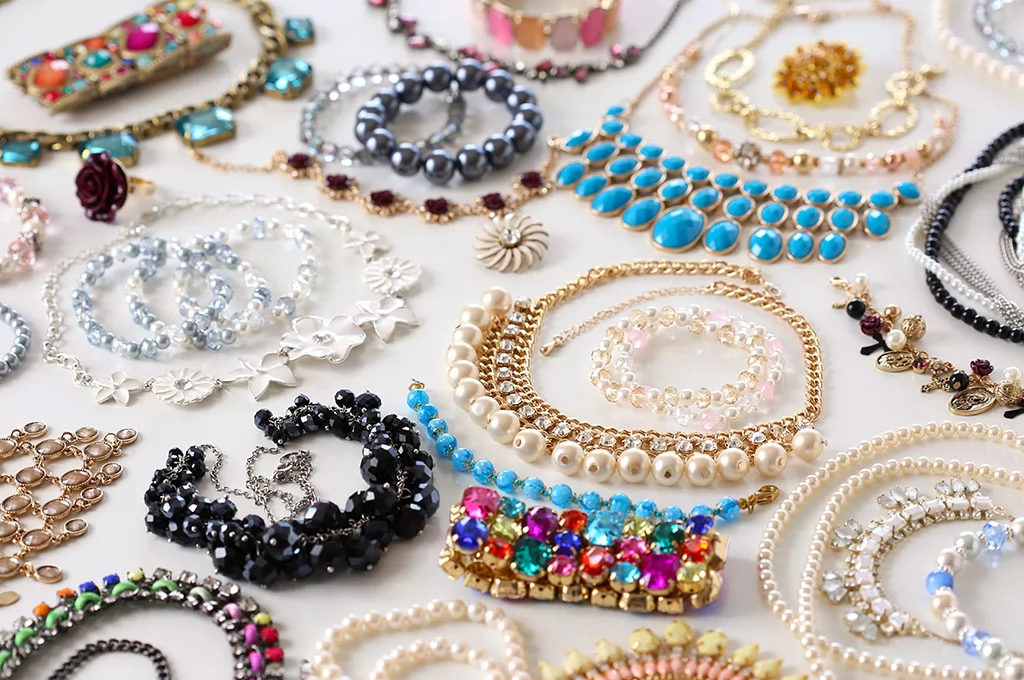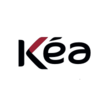Detailed content of our market study
 Inforamtion
Inforamtion
- Number of pages : 35 pages
- Format : Digital and PDF versions
- Last update :
 Summary and extracts
Summary and extracts
1 Market summary
1.1 Definition and presentation
The costume jewelry industry-from the French word bijouterie-is identified as a sub-segment of the broader jewelry market. To be classified as imitation jewelry for costume purposes, these items cannot contain more than small amounts of precious metals. They must be made primarily of base metal or non-precious materials (such as wood, glass or plastic). The broader category of costume jewelry, which has the characteristics just mentioned, includes three subcategories which, within the scope of this study, will be treated as one under the name "costume jewelry" since they have the same structural characteristics and differ only in the purpose of their use:
- Imitation Cost ume Jewelry: reproduction of jewelry with non-precious metals and stones. The term originated around the year 1930 when Hollywood began to prefer imitations rather than actual precious jewelry, mainly for safety issues. This type of jewelry, however, has been around for much longer, since the 1700s when the world of luxury began to be democratized and imitation jewelry allowed less wealthy individuals access to it.
- Branded costume jewelry also known as fashion jewelry, can still be considered imitation jewelry but is more connected to the latest fashion trends and is often used to make bold statements about one's sense of style without having to spend an inordinate amount of money.
- Fantasy jewelry these accessories are made from different types of metals and stones such as resins, glass, wood, mother of pearl, etc.
Accessories that are part of the world of personalized and fashion jewelry can be divided according to the type of product, and among the most relevant are:
- Necklaces
- Bracelets
- Earrings
- Rings
Globally, the custom jewelry market is experiencing an extremely prosperous period, driven more by an increasing focus on fashion and its trends than anything else. The market is extremely competitive and has few barriers to entry, being essentially based on the production of jewelry that is non-precious and therefore not made from expensive but aesthetically appealing raw materials.
In Italy, a country where jewelry and craftsmanship have a really important historical significance, households are spending on average more on costume jewelry than in the past, reflecting the global trend toward more affordable jewelry and amplifying it thanks to Italians' passion for handmade pieces.
The number of employees of companies active in the jewelry and costume jewelry sector in this country has consequently increased to account for almost a quarter of total employment in the same sector in the European Union in 2020 [ Eurostat ] .
The costume jewelry segment in Italy appears to be driven primarily by the growing impact of social media on purchasing choices and thus the evolution of online distribution channels, as well as the emergence of new styles and preferences such as personalization and the rising price of gold and silver
The main players in the sector that exclusively sell costume jewelry are "CA&LOU," a young company specializing in the creation of swarovskate jewelry, and Angela Caputi Giuggiù's "Angela Caputi," a designer specializing in the creation of scenic and artistic plastic jewelry. But this segment is also composed of increasingly important players who sell both precious and costume jewelry and come from both the fast fashion world and the world of large online wholesalers.
1.2 The global market
The global costume jewelry industry is a dynamic and growing sector that includes the manufacture and sale of non-precious jewelry and accessories. This market offers a wide range of products, including earrings, bracelets, necklaces, rings, brooches, and more. Costume jewelry is often made of inexpensive materials, such as plated metal, glass, plastic, synthetic stones, and artificial pearls, making it more affordable than jewelry made of precious materials such as gold and diamonds. The costume jewelry market is estimated to reach $**.* billion by ****, registering a CAGR of *.* percent from **** to ****.[***]
Size of the costume jewelry market World, ****-****, in billions of dollars Source: ****
There are several drivers to leverage on:
Market growth: the costume jewelry market is growing steadily worldwide; this is due to consumers' increasing preference for fashionable and personalized products Fashion trends and new styles in jewelry: costume jewelry is strongly influenced by fashion trends. In fact, designers and fashion brands often find themselves collaborating with jewelry designers to create coordinated collections Customer awareness and pursuit of sustainability: consumers are increasingly aware of the environmental and social impact of jewelry production, so there has been an increased demand for jewelry made from recycled or sustainable materials Growth of e-commerce: the ...
1.3 The Italian costume jewelry market
Regarding the analysis of the Italian jewelry market, it is necessary to dwell on one aspect: in the first seven months of ****, as much as *.* billion euros worth of products were exported outside national borders. In particular, Italian costume jewelry performed exceptionally well in the January-September **** period, touching nearly the figure of *** million euros, marking a ** percent increase over pre-pandemic levels. This sector is now the second largest sector in terms of value, surpassed only by goldsmithing and wearable jewelry, contributing * percent of total Italian jewelry exports. These figures reflect a dynamic and growing landscape, testifying to the strength and attractiveness of the costume jewelry sector in the Italian economic context.[***]
Value of production Italy, ****-****, thousands € Istat
the value of turnover provides insight into the health and dynamics of a specific economic sector, in this case, the costume jewelry sector. Data reflecting a significant increase in turnover, as in the case attested in ****, indicate a number of positive aspects: Economic growth: An increase in turnover suggests that the costume jewelry sector is experiencing economic growth, which can be attributed to various factors such as consumer demand, product innovation, or successful marketing strategies. Resilience: Exceeding pre-pandemic levels demonstrates the industry's resilience ...
1.4 Imports and exports in the non-precious stones and costume jewelry sector
As can be seen from the graph below, the export of the product is significantly higher than the value of imports. The only exception is ****, a year in which import growth of ** percent was established, almost reaching the value of exports and, graphically, decreasing the foreign trade coverage ratio. Drastic, however, was the following year, where a reduction of about ** percent in imports was affirmed. As for exports, made-in-Italy jewelry is mainly sold in non-European markets, representing **.* percent, while EU markets account for **.* percent.
Import - Export costume jewelry Italy, ****-****, Millions $ UN Comtrade
according to data reported by UN Comtrade, the top five consumer countries of products belonging to the field of costume jewelry are: USA, France, Germany, Japan and Australia. Distribution of exports among the top * consuming countries Italy, ****, % UN Comtrade whereas, the top five supplier countries: Austria, China, Germany, France and Indonesia. Distribution of imports among the top * supplier countries Italy, ****, % UN Comtrade
1.5 COVID-19 Impact
Global manufacturing has been hit by the shock caused by the pandemic, having recorded the lowest rate of expansion of industrial activity in the past decade. According to expectations, none of the major industrialized areas of the planet managed to avoid a sharp decline in value added in ****, with the exception of China, which recorded a moderate expansion. Against this backdrop, it has been difficult to predict how quickly manufacturing, which includes jewelry and costume jewelry production, will return to pre-crisis levels once the emergency is over. The impact of the pandemic on manufacturing activity levels in Italy was immediate and violent. In the two months of the first freeze (***), production fell by more than ** percent[***]
Federpreziosi conducted an interview with five hundred operators in the Italian jewelry and costume jewelry sector, who responded to a questionnaire with the aim of collecting relevant data to understand the impact of the pandemic on these businesses and find solutions that can help them deal with the crisis. The question posed to respondents was:"pcan you indicate, in general, the percentage of decrease in sales of your business from February ** to March *, ****, compared to the same period in the previous year?"
Percentage of decrease ...
1.6
2 Demand analysis
2.1 Demand characteristics
Demand for imitation jewelry and all of its subcategories is relatively elastic, as customers in this type of market are usually sensitive to changes in price, which, being lower than for fine jewelry, is one of the determinants of demand growth in the sector. In addition, this type of market is considered less seasonal than the market for expensive jewelry, where, on the other hand, demand grows for holidays, anniversaries, and festivities, and, as a result, products of this type are purchased less often.
Monthly household expenditure Italy, ****-****, € Istat
The survey conducted by Format Research (***). Precious jewelry purchases prevail among male consumers, aged **-**, most often residing in the country's large metropolitan areas.
MAN WOMAN Clothing **,* **,* Electronics and information technology **,* **,* Jewelry and watches **,* **,* **-** years **-** years **-** years **-** years old Over ** years old Clothing **,* **,* **,* **,* **,* Electronics and information technology **,* **,* **,* **,* **,* Jewelry and watches **,* **,* **,* **,* **,* Below is a mirror of the preferences of *** precious jewelry and costume jewelry customers surveyed by Format Research. Although gold and silver jewelry are more expensive, the customers surveyed prefer these products for different reasons; **.*% of respondents say they purchased a particular piece of jewelry because it was desired by the person for whom it was ...
2.2 Factors influencing demand
The demand of the jewelry industry, both precious and costume jewelry, was once strongly influenced by the search for a product that is unique, pure, and composed of rare materials. The ostentatious attitude is now supplanted by new and different needs. Purchases, today, are strongly influenced by the social interaction of the individual with the group, who wants to follow fashions that recently are also satisfied with imitation jewelry, composed of less valuable materials, but affordable to all pockets. One of the main reasons for the increase in consumption is related to the rise in gold prices, which has led to a rise in demand for non-precious jewelry for all those price-conscious consumers. The graph below highlights the increase in gold pricing; note well the **.* percent growth over the **** - **** period.[***]
Average gold price World, ****-****, in $ Source: ****
Another relevant trend that is shaping demand in the costume jewelry sector is the spread of e-commerce, which has led to a production of sales of about €*** Mln (***). Through the opening of online stores, the needs of the younger segment of shoppers are best met, who, on the other hand, are also those who pay more attention to price and, therefore, will be ...
2.3 Geographical distribution of demand
To visualize the geographic distribution, a map was constructed with monthly household spending in the field of costume jewelry and jewelry. The northeast presents the highest figure, with *.* €/month, followed by the northwest, where spending is *.** €/month while, in the south, households spend an average of only *.** €/month on costume jewelry products. The center also presents a good average figure, with an average expenditure of *.* €/month; the lowest figure remains that of the islands, whose average expenditure is *.** €/month. [***]
2.4 Social Content
The analysis offered by Format Research, based on a sample of twenty-four cases who used social to purchase precious jewelry and costume jewelry, highlights aspects about this type of experience. The social content that most influenced and determined consumers' choice of product, regardless of whether they purchased it at the jewelry store or online, was sponsored content (***). **.*% of buyers believe that jewelry stores are in step with the times and able to capture new consumer trends. Nearly **% feel differently.
Social content influential in product purchase Italy, ****, % Federpreziosi
Based on the previously proposed interview, it was asked by whom the above content was posted. Below is the data showing the predominance of brands operating in the industry. (***)
Market promoters on social Italy, ****, % Federpreziosi
2.5
3 Market structure
3.1 Market structure
Within the Italian jewelry industry, luxury and non-luxury, four categories of players can be distinguished: micro, small, medium and large enterprises. Further distribution is based on the two main stages of the supply chain, creating two classes: production and distribution. The vast majority of companies in Italy are small, characterized by artisanal production, with an average number of employees per company of about *[***]
More than three-quarters (***) of the sector, and exceeding the number of workers in the entire German jewelry industry.[***]
Enterprises active in the manufacture of costume jewelry and similar articles Italy, **** Istat
The sub-segment of the Italian costume jewelry market as of **** consisted of **** enterprises[***]. Enterprises active in the sector can be further divided by type, taking into account the different legal forms of enterprises covered by Italian jurisdiction.
Breakdown of enterprises in costume jewelry by type Italy, ****, % Istat
As can be seen from the graph, most of the businesses are owned by independent entrepreneurs reflecting the trend observed in the broader jewelry market toward micro and small businesses.
3.2 Competition and strategy
Historically, the Italian gold sector has developed following the typical dynamics of industrial districts. The term "industrial district," coined by Alfred Marshall in the second half of the **th century, identifies a socio-economic entity formed by a set of enterprises that are part of the same production system located within a circumscribed area. In addition, the said enterprises are linked by collaborative relationships and simultaneously compete with each other.
The various districts are represented by the Federation of Italian Districts, which was established in **** with the aim of promoting and at the same time protecting the Italian production sector on the international scene.
The world of Italian jewelry has been constantly evolving over the past ** years, and has undergone radical transformations especially with regard to style, which has become a key element being a fundamental tool of differentiation. Today, the search for originality and innovation is widespread and focuses on the design and symbology of the offering
Competition has thus been made less homogeneous and the pace of change has been intensified by this new design momentum, linked to the entry of new players from the fashion world and other fields. The key success factors for thriving in this reshaped market ...
3.3 Distribution channels
The main distribution channels active in the jewelry and costume jewelry market in Italy are:
Traditional jewelry stores: traditional jewelry stores are identified with the figure of the jeweler and remain one of the most popular places to buy jewelry, watches and silverware. Within a jewelry store you can choose from a mix of branded and non-branded products; Traditional jewelry stores in shopping malls Multi-brand chains: independent stores or large chains located within malls with displayed prices and no barriers to entry. They feature a multi-brand assortment and items created specifically for the chain based on their own ideas and designs (***); E-commerce sites (***): marketplaces are intermediary Internet sites where commercial exchanges of goods or services take place. The main characteristic of Marketplace is the breadth of supply and the presence of multiple sellers. Compared with individual e-commerce, the Marketplace is able to provide a greater range of products and greater security at the purchase stage Online stores of famous brands (***): single-brand e-shops of well-known brands represent a competitive reality for traditional jewelry stores as they come with a refined and elegant design, user-friendly features and specialized sales staff. Jewelry store website : E-commerce represents a winning strategy for today's jewelry stores that ...
3.4 Main actors
LEO FRANCE - S.R.L.: Leo France makes both costume jewelry and accessories for clothing, bags and other leather goods, trying to transform the ideas proposed by the big fashion houses, into high quality items with excellent value for money. GIMET BRASS S.R.L.: Gimet Brass is a company specializing in the manufacture of brass chains and small parts. The production is intended for multiple realities, from the smallest, artisanal and creative, to the most structured in the world of high fashion. C.D.C. S.R.L.: The company's main specialization is the production of ornamental chains in non-precious base metals, made both mechanically and manually. IL GIOIELLO DI FIRENZE S.R.L.: Il Gioiello was founded in **** as a small button factory, specializing in its early years in the production of buttons of all types and materials. Gabriele Nuti, the founder, transformed the business over the years, expanding the range of products to all fields of costume jewelry. CHIMERA ORO S.R.L.: Chimera Oro S.R.L.: Chimera Oro was founded in ****; it has produced gold and silver jewelry internationally and, in the last decade, has successfully devoted itself to the design, development and production of ...
4 Supply analysis
4.1 The composition of the product offering
Costume jewelry often incorporates the following metals and materials:
Non-precious metals: brass, steel, zinc casting, tin casting, vermeil; Semi-precious metals: silver, gold- or silver-plated brass and other alloys; Non-metallic materials: leather, fabric, resins, ropes, natural wood, coconut shavings, dyed or engraved or cracked shells, etc; Non-precious or semiprecious stones, including crystals and cubic zirconia
In addition, accessories that are part of the custom and fashion jewelry world can be divided according to product type, and among the most relevant are:
Necklaces Bracelets Earrings Rings
4.2 Prices of major categories of jewelry and costume jewelry
it is evident that the market is mainly divided into two segments: high-end jewelry-precious jewelry-and costume jewelry. Between the two, we can identify an intermediate segment, called "Bridge Jewelry," which includes jewelry products made of silver and semi-precious materials.
Source: ****
Regarding the free on board (***) price should be calculated to include:
Production costs (***) Administration costs (***); Transportation and marketing costs (***); Cost of using a marketplace platform such as Google, Amazon, etc. (***).
4.3 Trends in CPI and prices for the sector
The Harmonized Consumer Price Index category "Jewelry, watches, and clocks (***)" is a classification of durable goods that includes precious stones and metals and jewelry made from such stones and metals; costume jewelry, cufflinks and tie clips, clocks, watches, stopwatches, alarm clocks, travel clocks, and repair of such items
We can then use this index and its evolution over time to more deeply analyze the sectors and its prices
Harmonized CPI: Jewelry, watches and clocks Italy, ****-****, Index ****=*** Source: ****
It is clear from the graph that the period between January **** and January **** witnessed a strong increase in the CPI therefore exemplifying an increase in prices for the goods included in the basket uses, within which, costume jewelry.
5 Rules and regulations
5.1 Market regulatory framework
The Consumer Code(***) harmonizes and reorganizes regulations on purchasing and consumption processes in order to ensure a high level of consumer and user protection in compliance with the Constitution and in accordance with the principles of European Union law.
Safety, composition and quality of products constitute the essential content of information obligations towards the consumer (***). With regard to personalized jewelry products, the information provided to the consumer must be:
Adequate to the communication technique used; Expressed in a clear and understandable manner; Such as to ensure the consumer's awareness. (***).
In addition, they must include as per Art. * of the Consumer Code:
Legal or commodity name of the product; Name, company name or trademark and registered office of the manufacturer or importer; Country of origin if outside Europe; Possible presence of harmful materials or substances; Materials used and processing methods if they determine the quality or characteristics of the product; Instructions, precautions, and intended use if useful for the use and safety of the product
In the event that these requirements are not met and the above information is not correctly displayed on the packaging or labels at the retail stage, there will be a ban on the marketing of jewelry products, ...
6 Positioning of actors
6.1 Segmentation
- Leo France
- Gimet Brass
- Chimera Gold
- C.D.C.
- Gidue
- Chimera Oro
- Il Gioiello di Firenze
- Giemme di D'Agostino
All our studies are available online in PDF format
Take a look at an example of our research on another market!
 Choosing this study means :
Choosing this study means :
Access to more than 35 hours of work
Our studies are the result of over 35 hours of research and analysis. Using our studies allows you to devote more time and added value to your projects.
Benefit from 6 years' experience and over 1,500 industry reports already produced
Our expertise enables us to produce comprehensive studies in all sectors, including niche and emerging markets.
Our know-how and methodology enable us to produce reports that offer unique value for money.
Access to several thousand articles and paid-for data
Businesscoot has access to all the paid economic press as well as exclusive databases to carry out its market research (over 30,000 articles and private sources).
To enhance our research, our analysts also use web indicators (semrush, trends, etc.) to identify market trends and company strategies. (Consult our paying sources)
Guaranteed support after your purchase
A team dedicated to after-sales service, to guarantee you a high level of satisfaction. +44 238 097 0676
A digital format designed for our users
Not only do you have access to a PDF, but also to a digital version designed for our customers. This version gives you access to sources, data in Excel format and graphics. The content of the study can therefore be easily retrieved and adapted for your specific needs.
 Our offers :
Our offers :
the costume jewelry market | Italy
- What are the figures on the size and growth of the market?
- What is driving the growth of the market and its evolution?
- What is the positioning of companies in the value chain?
- Data from several dozen databases
5 reports pack (-15%) IT Italy
- 5 reports at €75.6 excluding VAT per study to choose from our Italian catalogue for 12 months
- Save 15% on additional studies purchased
- Choose to be refunded any unused credit at the end of the 12-month period (duration of the pack)
See the terms and conditions of the pack and the refund of unused credit.















